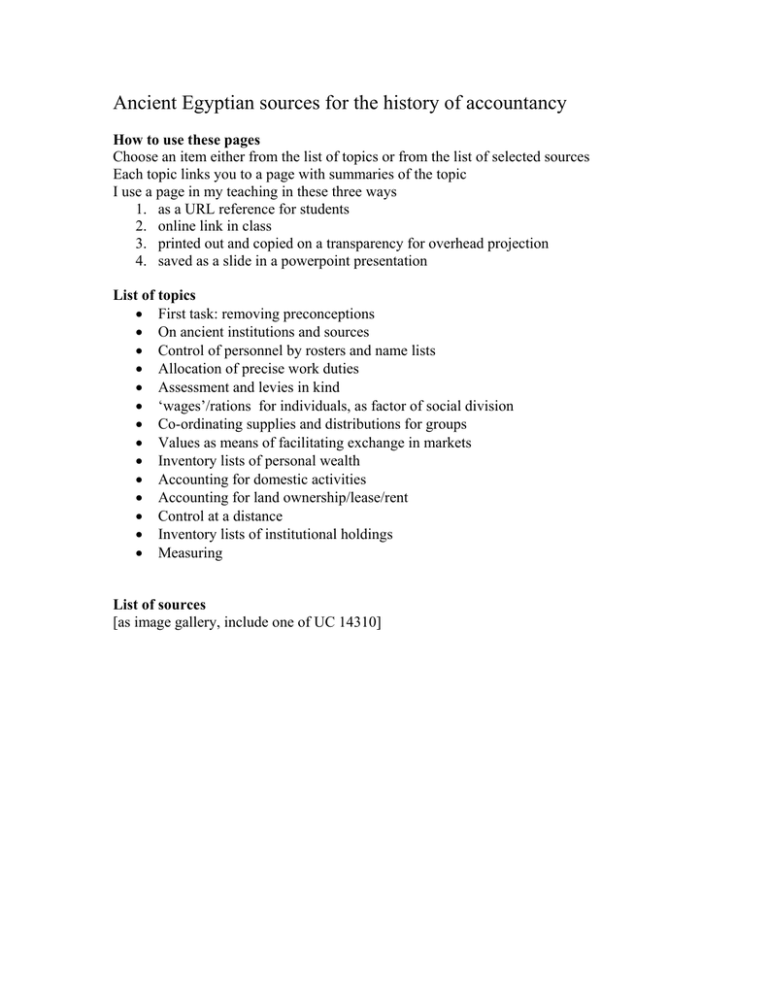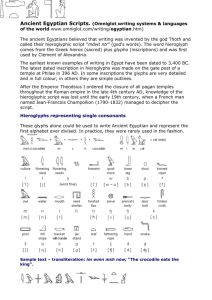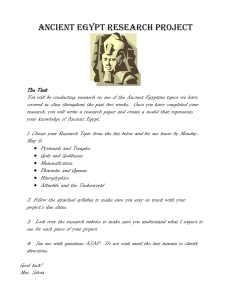Ancient Egyptian sources for the history of accountancy
advertisement

Ancient Egyptian sources for the history of accountancy How to use these pages Choose an item either from the list of topics or from the list of selected sources Each topic links you to a page with summaries of the topic I use a page in my teaching in these three ways 1. as a URL reference for students 2. online link in class 3. printed out and copied on a transparency for overhead projection 4. saved as a slide in a powerpoint presentation List of topics • First task: removing preconceptions • On ancient institutions and sources • Control of personnel by rosters and name lists • Allocation of precise work duties • Assessment and levies in kind • ‘wages’/rations for individuals, as factor of social division • Co-ordinating supplies and distributions for groups • Values as means of facilitating exchange in markets • Inventory lists of personal wealth • Accounting for domestic activities • Accounting for land ownership/lease/rent • Control at a distance • Inventory lists of institutional holdings • Measuring List of sources [as image gallery, include one of UC 14310] First task: removing preconceptions Before you consider sources from ancient Egypt on accountancy and the economy, consider preconceptions and prejudices you may have. Here are four examples, with counter-arguments: 1. Are you expecting ancient sources to answer your questions directly? Remember that we do not know the basic operation of land ownership – you may read in books on ancient Egypt that the king owned all the land, but this is modern speculation, not a principle established by the sources. The sources are finite and specific: it helps to know their number, context and limitations. 2. Are you assuming a specific economic structure or framework? Remember that ancient Egypt belongs in time and place outside the bounds of preindustrial non-stratified societies as well as of industrial and post-industrial capitalist or socialist societies. 3. Do you assume economic rationality as the driving force underpinning actions? Consider the variety of ‘rational’ and ‘non-rational’ motives in human action, and the impact of these. 3. Do you assume societies without coins to operate by barter? Ancient Egypt was a nation state with urban centres and international trade routes. Its economy did not involve coinage, but nor did it operate on a flat level of interpersonal relations. Its commodity valuations do not fit with the Western perception of village barter, but rather involve ‘monies’ of account as common denominators converting objects into some form of economic equivalents. 4. Do you assume lower complexity for human beings working with different institutions from those in operation today? Human society of whatever scale involves complexities of individual and social relationships, and economic relations are a part of that: there is no ‘simple’ society, or individual – we are all complex. On ancient institutions and sources What we do not know: the redistribution question It is often assumed that the ancient Egyptian economy operated as a centralised unit in which the king/centre collected and redistributed national resources. Specifically, many accounts of the ancient Egyptian economy take at face value ancient written statements that the king was lord (interpreted as owner) of the land. Modern commentators also often assert that there were kingly monopolies on economic operations, such as foreign trade. • Are such statements ideological? Or do they reflect a juridical reality? • How does the archaeology of local wealth square with a formal image of central control and redistribution? • If there was a mixed economy of central/state/public and local/personal/private, how large was each sector? • Can we use modern economic terminology for an ancient economy? If we cannot use public/private, for example, how can we describe ancient economies? Economy and estate • Egyptian word pr ‘house’ with different meanings, notably ‘living-space’ and ‘estate’ (lands regularly producing resources for those in the living-space) • These two different meanings encourage a tripartite division of the ‘house’ (applicable to the wider economy) into (1) living-quarters with luxury items and place for consumption of commodities converted into meals, (2) food-producing area where commodities are converted into meals (broadly equivalent to a ‘kitchen area’), (3) fields for crops and herds (can be scattered across regions) Institutions Kingship • King is son of the sun-god – mortal life-span, human form, divine essence • King corresponds to supreme executive and judicial authority • Egypt is an early state not a modern state: it corresponds to a single political unit covering speakers of one language, ancient Egyptian, and has relatively clearly defined borders BUT it does not show a modern-style separation of powers (judiciary, executive, military, religious, administrative) – some authors prefer to avoid the word ‘state’ and use the word ‘kingship’ instead to emphasise the lack of separation between these aspects of rule Administration • Modern commentators have tended to use the word ‘title’ to cover a variety of types of designations for individuals, some allotted by a central or local authority, others self-descriptive; context determines usage – there are both ad hoc and more enduring roles, and various ways of expressing the role of a person • Egyptian title for head of administration is TAty conventionally translated ‘vizier’ in Egyptology • Inscription in four New Kingdom tombs of viziers records ‘Duties of Vizier’ • Principal role is co-ordinator of sectors, of labour deployment • Prominence of bureaucratic dimension (title ‘scribe’ equivalent to ‘accountant’) Treasury • Egyptian term equivalent to ‘treasury’ is pr-HD, literally ‘White House’, attested from the Early Dynastic (about 3000 BC) • Top official for treasury is ‘overseer of sealed items’ (usually rendered ‘treasurer’), or in some periods ‘overseer of the White House’ • Treasury covers all commodities, but there is a focus on the more precious ‘sealed’ items (items ‘sealed’, locked away, because of their value) • Note our incomplete knowledge of relation between administration of luxury items and administration of staples – compare separation of house=estate and house=living-quarters, above Fields • The agricultural cycle revolves around the harvest of barley and, to a lesser extent, emmer wheat, with harvest in spring/early summer • Harvest is crisis time in agricultural economies, mobilizing all available labour: fields administration is partly about calculating revenue before or after harvest, and partly about mobilizing labour • The title ‘Overseer of fields’ is among higher titles at some periods • There is little evidence for central state interest in maintaining fields or irrigation networks: the central state becomes involved at the collection of revenue • The juridical status of lands is uncertain, so the collection of revenue may be either rent or levy: the levy seems more a sporadic call for resources than a regular annual levy in the style of a modern tax Granary • Grain is main currency, making the granary a principal bank • The title ‘Overseer of the Granary’ (often ‘Double Granary’ – double to denote the national as opposed to local reach of the title) is prominent in some periods, not in others; at all periods administration of grain resources is crucial, given the variations in the height of the river Nile in its annual cycle of flood and low water Institutions attested in some periods, not in others Labour • Middle Kingdom sources refer to a ‘Bureau for labour deployment’ (xA n dd rmT): this is not identifiable in other periods, and may relate to a stricter regime of ‘national service’ in this period • Middle Kingdom sources include ‘census’ documents, headed wpwt ‘breakdown (of persons in a house-unit/estate)’: other lists of ‘houses’ and of households are preserved from the late New Kingdom (list of ‘houses’ on the West Bank at Thebes) and Ptolemaic Period (for example, demotic and Greek lists of names and professions, from Rifa in Middle Egypt, third century BC) Temple • Egyptian religion allotted sacred space to three types of being: gods, kings, and the blessed dead (broadly speaking, recent generations of dead in the family) • Before New Kingdom, temples of gods, as opposed to those of kings, are not prominent in administration • • From the New Kingdom on, main temple in each city is a substantial architectural complex with large enclosure wall, making it an ideal secure store for large quantities of grain as well as for high-value commodities: the temple of Amun-Ra at Karnak (ancient Thebes) acts as a kind of holding bank for the state Note that there is no clear state-temple opposition or tension, even in the later periods when temple architecture is most impressive: much modern writing about Egypt assumes such an opposition, with alleged ‘priestly’ control of resources, but (1) the relations between kingship, institutions, estates remain complex and only partly understood, (2) the elite is not easily divisible into separate sections such as military, temple priesthood (so-called ‘clergy’), bureaucracy – instead, the surviving sources attest to the same elite families across these sectors, and at least a theoretical central control of appointments. In the old theory of state-temple opposition, it was assumed that the Amun-Ra priests took control of Thebes at the end of the New Kingdom: postwar research has tended to show that the New Kingdom ended with the rise of, not priests, but generals, of western desert nomadic origin (‘Libyans’) Principal surviving written sources 3100-1100 Place-names denote find-place or, when in brackets, place where now preserved 1. accounts manuscripts, being papyri, sometimes leather rolls, and in some periods large numbers of ostraca (pottery or limestone fragments used for quick and cheap recording) 3100-2500 none (see 2. below for hieroglyphic sources) 2500-2000 Abusir Papyri; Gebelein Papyri 2000-1850 the four Heqanakht Letters, related accounts; the four Papyri Reisner 1850-1600 the temple accounts (Berlin) and miscellaneous town documents (London) from Lahun; papyrus with two labour registers (Brooklyn); papyrus with accounts of the court of a 13th Dynasty king (Cairo) 1600-1350 great mathematical manual (Rhind Papyrus, London); Dates/Grain Papyrus (Louvre); about four hundred ostraca from Deir el-Bahri building projects; two records of palace expenditure and income, and dockyard accounts (two Papyri Hermitage) 1350-1100 thousands of ostraca and papyri from Deir el-Medina; Gurob Papyri; two ship logs and related letters (Leiden); Asyut papyrus with cargo accounts (Amiens/London); Middle Egypt land records (Wilbour Papyrus, Brooklyn) 2. hieroglyphic sources 3100-2500 in this period only commodity labels and short hieroglyphic inscriptions 2500-2000 longer hieroglyphic inscriptions include first donation and legal inscriptions 2000-1600 longer hieroglyphic inscriptions include detailed record of outgoings and income at court of king Amenemhat II for one year (about 1900 BC) 1600-1350 longer hieroglyphic inscriptions include detailed record of military campaigns and donations of king Thutmose III (about 1450-1400 BC) 1350-1100 longer hieroglyphic inscriptions include records of campaigns and donations, and great list of festivals at temple of king Ramses III at Medinet Habu, Thebes






